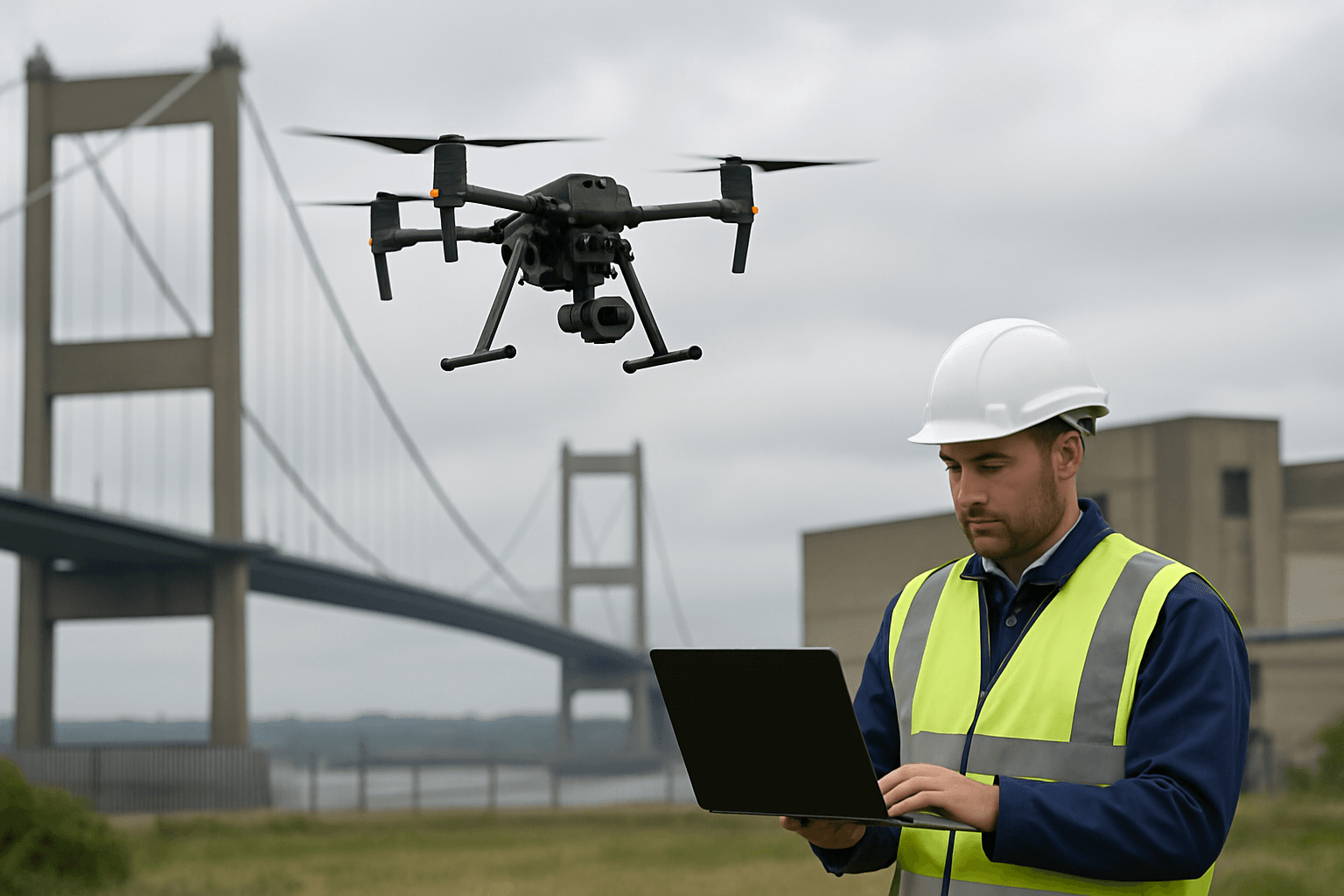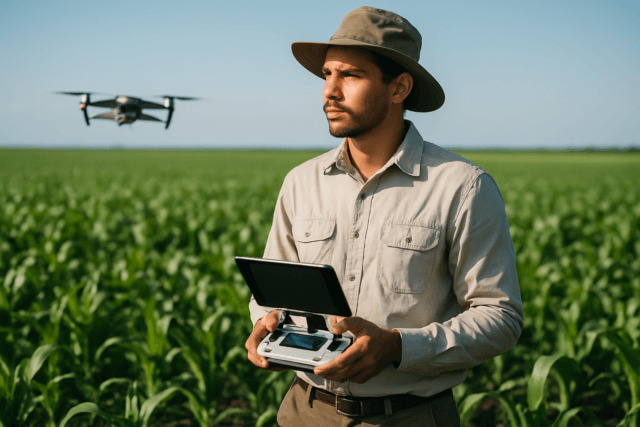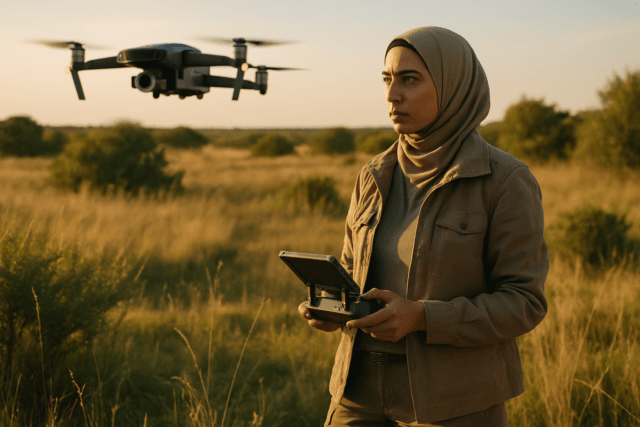Drones are rapidly transforming the way businesses operate across the UK, offering unprecedented opportunities for cost savings and increased efficiency. From construction and agriculture to public safety and logistics, drone technology is delivering substantial returns on investment (ROI) by streamlining operations, improving data collection, and enhancing safety. This article explores the multifaceted ways in which drones are driving down costs and boosting efficiency for UK businesses and organizations.
The Economic Edge of Drones
Drones are proving to be a “time- and money-saving” technology in 2025, offering quantifiable savings that are driving further adoption across industries. In the UK, recent reports indicate that drone mapping can be hundreds of times faster and 40% cheaper than traditional ground surveys. Replacing police helicopters with drones can cut costs by approximately 55%, translating to significant annual savings.
Key Factors Influencing Drone ROI
Several factors contribute to the impressive ROI of drone technology:
- Purchase and Setup Costs: While high-end drones for industrial applications may have a higher initial cost (ranging from £30,000 to upwards of £200,000), they often deliver significant ROI due to their advanced capabilities and efficiency.
- Labour and Time Savings: Drones replace costly and time-consuming manual tasks such as inspections, land surveys, and crop analysis, significantly reducing labour expenses and project timelines.
- Revenue Generation: Drones can directly generate income through services like aerial photography, mapping, deliveries, and inspections, creating new revenue streams for businesses.
- Operational Efficiency: Faster data collection and improved accuracy lead to better decision-making, optimizing resource allocation and minimizing errors.
- Maintenance and Downtime: Proper drone care ensures long-term ROI by preventing costly breakdowns and extending the lifespan of the equipment.
Industry-Specific Cost Savings in the UK
1. Construction
Drones are revolutionizing construction project management by:
- Revolutionizing Site Surveys and Mapping: Drones equipped with advanced cameras and sensors capture high-resolution images and data, creating detailed 3D maps and models of construction sites in hours instead of weeks. This results in more accurate, safer, cost-effective, and repeatable surveys.
- Real-Time Progress Tracking: Drones provide real-time data on project progress, enabling better decision-making, improved communication, and proactive problem-solving. Weekly drone flights replace manual site checks, resulting in 20–30% time savings on surveying and progress tracking tasks.
- Nailing Precision in Earthwork and Site Prep: Drones bring unprecedented precision and efficiency to earthwork operations by creating detailed 3D models for accurate cut and fill calculations, enabling regular progress tracking with frequent surveys, and guiding grading equipment for maximum efficiency with drone-generated maps.
- Streamlining Equipment and Materials Management: Drones conduct quick inventory counts of material stockpiles, track equipment with regular flyovers, verify deliveries, deter theft through regular aerial surveillance, and optimize layout with bird’s-eye views for maximum efficiency.
- Safety & Rework: Thermal drones spot overheating gear or leak risks early, reducing accidents and shutdowns. By catching errors (cracks, misalignments, etc.) sooner, drones also minimize expensive rework.
Quantifiable Savings:
- A construction firm saved $1.7 million by using drone surveying instead of traditional methods.
- In one 9-month project in Sheffield, drones replaced scaffolding for facade inspections and saved £30,000 in scaffolding and inspection costs.
- Barratt Developments used drones on a housing site survey and cut £20,000 in labour costs.
2. Agriculture and Precision Farming
Drones are transforming agricultural practices by:
- Crop Health Monitoring: Drones equipped with multispectral cameras can survey vast areas, providing data on crop health, irrigation needs, and pest management, reducing chemical usage and increasing yields.
- Efficient Field Application: Drones can reduce field application costs by up to 90% through automation of battery and payload management.
- Targeted Resource Consumption: Revolutionizing how farmers manage their fields, improving crop health and yield while reducing resource consumption.
Quantifiable Savings:
- Drones equipped with multispectral cameras can reduce chemical usage by up to 40% and increase yields by up to 20%.
- Agricultural operations using drones for crop health assessments report yield improvements of 5–15% and reductions in chemical usage, translating into higher profit margins per acre.
3. Infrastructure and Asset Inspection
Drones are revolutionizing infrastructure and asset inspection by:
- Buildings & Bridges: Drones replace costly scaffolding and lifts on bridges, towers and high-rise facades, often completing surveys in a few hours. Routine asset inspections that once required heavy equipment are now handled cheaply from the air.
- Energy and Resource Industry: Energy and utility companies are using drones instead of helicopters to perform inspections of refineries, offshore rigs, and power lines, which is more affordable and environmentally friendly. Renewable energy businesses employ drones to examine solar panels and wind turbines.
Quantifiable Savings:
- Renfrewshire Council (Scotland) cut roof-inspection costs by millions per year using drones.
- Drone turbine/blade inspections cost only 20–25% of manual methods.
- A bridge inspection that might cost $10,000 traditionally could be completed for as little as $5,000 with a drone.
4. Public Safety
Drones are enhancing public safety operations by:
- Police & Emergency Services: Law enforcement is already seeing big gains – one study found NPAS (police air service) operations shifted to drones cut costs 55.4% (about £22.6m/yr savings).
- Coastguard & SAR: The Maritime and Coastguard Agency estimates roughly £1.6m/yr in operating costs saved by using drones for search-and-rescue and patrols. Drones can hover on station much more cheaply than rescue helicopters, speeding up response and cutting fuel and personnel costs.
- Disaster Response: Drones can be deployed within minutes, offering immediate insights into disaster zones, which is critical for time-sensitive scenarios. By reducing reliance on large-scale human and vehicle deployments, drones can significantly cut operational costs. Drones minimize the risks to human responders by navigating hazardous environments such as fire zones or collapsed structures. Advanced sensors provide actionable insights that improve decision-making, reducing waste and optimizing resource allocation.
5. Surveying and Mapping
Drones offer a faster, more accurate, and cost-effective alternative to traditional surveying methods:
- Land Development: Drone surveys can be up to 400 times faster and 40% cheaper than traditional methods.
- Site Uptime: Quicker mapping reduces site downtime by up to 40%.
- 3D Modeling: Drones can generate millimeter-accurate 3D models in hours instead of days, preventing costly rework.
Quantifiable Savings:
- Barratt Developments used drones on a housing site survey and cut £20,000 in labour costs.
6. Logistics and Delivery
Drones are streamlining logistics and delivery operations by:
- Faster Deliveries: Drones offer the potential to cut operational costs, improve delivery speed, and optimize supply chains.
- Reduced Costs: Depot-based drone delivery can lead to significant cost savings compared to truck-only delivery, especially in low-demand areas.
Quantifiable Savings:
- Model results showed that depot-based drone delivery led to up to 60 percent cost savings compared to truck-only delivery when servicing low demand in small areas.
Beyond Monetary Savings
The benefits of drone adoption extend beyond direct cost reductions:
- Enhanced Safety: Drones minimize risks to human responders by navigating hazardous environments, reducing insurance premiums and injury-related costs.
- Environmental Impact: Drones operate with near-zero emissions, making them an eco-friendly alternative to traditional equipment.
- Zero Downtime: Drones don’t require shutting down infrastructure during inspections, saving companies thousands to millions of pounds in avoided downtime.
- Improved Decision-Making: Advanced sensors provide actionable insights that improve decision-making, reducing waste and optimizing resource allocation.
- Reputation and Trust: Organizations employing advanced drone technology build trust among stakeholders and communities.
Challenges and Considerations
Despite the numerous benefits, businesses should be aware of the challenges associated with drone implementation:
- Initial Investment: High-quality drones and specialized software can require a significant upfront investment.
- Regulatory Compliance: Navigating the legal and regulatory landscape for drone operations can be complex and time-consuming.
- Training and Expertise: Proper training is essential to ensure safe and effective drone operations.
- Weather Limitations: Drone operations can be affected by adverse weather conditions.
- Public Perception: Addressing concerns about privacy and safety is crucial for gaining public acceptance of drone technology.
Maximizing ROI: Best Practices
To maximize ROI with drone services, businesses must:
- Identify Specific Needs: Determine the specific areas where drones can provide the most value.
- Choose the Right Equipment: Invest in drones and sensors that fit your needs and budget.
- Invest in Training: Ensure that drone operators are properly trained and certified.
- Optimize Workflows: Integrate drone data into existing workflows for maximum efficiency.
- Comply with Regulations: Adhere to all applicable regulations and safety guidelines.
- Analyze Data: Use drone data to make informed decisions and improve operations.
The Future of Drone Cost Savings
As drone technology continues to evolve, the potential for even greater cost savings will only increase. Future trends include:
- Increased Automation: Automated drone systems will further reduce labour costs and improve efficiency.
- Improved Battery Life: Longer flight times will enable drones to cover larger areas and perform more complex tasks.
- Advanced Sensors: New sensors will provide even more detailed and valuable data.
- AI-Powered Analytics: AI will enable faster and more accurate analysis of drone data.
- Expanded Applications: Drones will be used in new and innovative ways across a wider range of industries.
Calculating ROI for Drone Services
To calculate ROI for drone services, follow these steps:
- Determine the initial investment: Include equipment, software, and training costs.
- Estimate the annual cost savings: Include reduced labour, improved efficiency, and decreased maintenance costs.
- Calculate the annual revenue generated: Include increased crop yields, more efficient construction projects, or higher property sales.
- Subtract the initial investment and annual costs from the annual revenue.
- Divide the result by the initial investment to obtain the ROI.
Conclusion
Drones offer immense potential for UK businesses seeking to improve their operations and maximize ROI. By selecting the right service provider, investing in training, and optimizing workflows, businesses can harness the power of drone technology to drive growth and success. As drone technology continues to evolve and regulations adapt, the question isn’t “Can we afford to use drones?” It’s becoming “Can we afford not to?”





